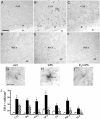Estrogen receptor-alpha mediates the brain antiinflammatory activity of estradiol
- PMID: 12878732
- PMCID: PMC170966
- DOI: 10.1073/pnas.1531957100
Estrogen receptor-alpha mediates the brain antiinflammatory activity of estradiol
Abstract
Beyond the key role in reproductive and cognitive functions, estrogens have been shown to protect against neurodegeneration associated with acute and chronic injuries of the adult brain. Current hypotheses reconcile this activity with a direct effect of 17beta-estradiol (E2) on neurons. Here we demonstrate that brain macrophages are also involved in E2 action on the brain. Systemic administration of hormone prevents, in a time- and dose-dependent manner, the activation of microglia and the recruitment of peripheral monocytes induced by intraventricular injection of lipopolysaccharide. This effect occurs by limiting the expression of neuroinflammatory mediators, such as the matrix metalloproteinase 9 and lysosomal enzymes and complement C3 receptor, as well as by preventing morphological changes occurring in microglia during the inflammatory response. By injecting lipopolysaccharide in estrogen receptor (ER)-null mouse brains, we demonstrate that hormone action is mediated by activation of ERalpha but not of ERbeta. The specific role of ERalpha is further confirmed by comparing the effects of ERs on the matrix metalloproteinase 9 promoter activity in transient transfection assays. Finally, we report that genetic ablation of ERalpha is associated with a spontaneous reactive phenotype of microglia in specific brain regions of adult ERalpha-null mice. Altogether, these results reveal a previously undescribed function for E2 in brain and provide a mechanism for its beneficial activity on neuroinflammatory pathologies. They also underline the key role of ERalpha in brain macrophage reactivity and hint toward the usefulness of ERalpha-specific drugs in hormone replacement therapy of inflammatory diseases.
Figures




References
-
- Sherwin, B. (2002) Trends Pharmacol. Sci. 23, 527-534. - PubMed
-
- Freeman, M. P., Smith, K. W., Freeman, S. A., McElroy, S. L., Kmetz, G. E., Wright, R. & Keck, P. E., Jr. (2002) J. Clin. Psychiatry 63, 284-287. - PubMed
-
- Huber, T. J., Rollnik, J., Wilhelms, J., von zur Muhlen, A., Emrich, H. M. & Schneider, U. (2001) Psychoneuroendocrinology 26, 27-35. - PubMed
-
- Henderson, W. (1997) Neurology 48, S27-S35. - PubMed
-
- Yaffe, K., Sawaya, G., Lieberburg, I. & Grady, D. (1998) J. Am. Med. Assoc. 9, 688-695. - PubMed
Publication types
MeSH terms
Substances
Grants and funding
LinkOut - more resources
Full Text Sources
Miscellaneous

